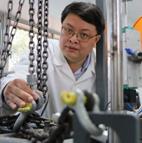Invited Speaker----Dr. Shanyong Wang

Professor, School of Engineering, The University of Newcastle, Australia
Dr. Shanyong Wang is a full Professor at the School of Engineering at The University of Newcastle, Australia. He obtained his PhD at the City University of Hong Kong in 2007. In September 2007, he moved to the USA and worked as a full time postdoctoral research fellow at the Catholic University of America (CUA). In November 2008, he joined the Centre for Geotechnical and Materials Modelling (CGMM) at the University of Newcastle, Australia. In January 2019, Dr Wang was promoted to Professor at the University of Newcastle. His expertise and research interests lie in advanced computational analysis of soft soil deformation and improvement and fractures evolution in brittle materials such as concrete and rock by the finite element and discrete element methods, as well as the experimental study of loose fill slopes and soil nail combined with grouting. Since 2002, he has published 165 international journal articles and conference papers. In addition, he is an Editorial Board member for seven international SCI journals: Soils and Foundations, Canadian Geotechnical Journal, Computers and Geotechnics, Rock Mechanics and Rock Engineering, Proceedings of ICE-Geotechnical Engineering, Bulletin of Engineering Geology and the Environment, and Journal of Rock Mechanics and Geotechnical Engineering. He was elected a Fellow of the Institution of Engineers Australia, and a Member of American Society of Civil Engineers (ASCE) in 2017.
Speech Title: Experimental study of a new compaction-grouted soil nail in sand
Abstract: This study proposed a new soil nail known as the compaction-grouted soil nail and a physical model was established to investigate its pull-out behaviour with different grouting pressures. The study on scale effect of the physical model was performed subsequently via numerical modelling. Additionally, interface shear tests were performed using the same boundary conditions as the physical model test. The strength parameters obtained were used to estimate the pull-out resistance of a conventional soil nail. The merits of these two soil nail types were compared based on their pull-out resistances. The physical model test results showed that the pull-out resistance of the compaction-grouted soil nail increases with increasing grouting pressure. In addition, the pull-out resistance exhibits hardening behaviour without a yield point, indicating that the compaction-grouted soil nail enables soils to remain stable against a relatively large deformation before ultimate failure. Furthermore, a higher grouting pressure results in a higher rate of increase for pull-out resistance versus pull-out displacement, which improves the performance of the compaction-grouted soil nail in the stabilization of large deformation problems. A comparison of the two types of soil nails suggests that the new compaction-grouted soil nail is more sensitive to grouting pressure than the conventional soil nail in terms of pull-out resistance improvement. In other words, the performance (pull-out resistance) of the compaction-grouted soil nail can be markedly improved by increasing the grouting pressure without inducing any accidental or undesired cracking or soil displacement.



